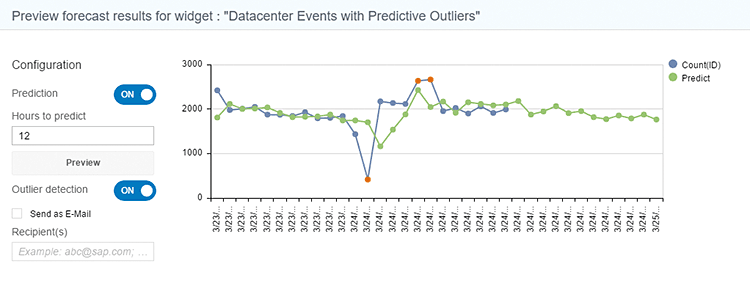From Reactive to Proactive IT Management
How SAP IT Operations Analytics and SAP Predictive Analytics Enable You to Survive and Drive Digital Transformation
The world of IT is rapidly changing as trends such as the cloud, outsourcing, virtualization, globalization, and mergers lead to increasingly complex landscapes, higher demand for “five nines” uptime, progressively stricter service level agreements (SLAs), and, most importantly, the drive for digital transformation.
Digital transformation demands IT leaders be innovative and anticipate business and user needs as they guide the organization into the digital world. But doing so requires resources in a world of limited budgets and great pressure to do more with less. To free up the necessary resources, IT leaders must be efficient, effective, and lean. Any solutions implemented must meet the changing needs and demands facing IT; teams need to avoid duplicate effort and finger pointing, and instead focus on optimizing allocation, anticipating incidents, and shifting from a reactive approach to a proactive approach to IT management. This isn’t change for the sake of change; companies that pursue such initiatives on the way to end-to-end IT operations visibility have been found to be three times more likely to fix issues more quickly, more than two-and-a-half times more likely to have lower IT error rates, and more than two times more likely to have high availability of IT systems and services.
SAP offers two key solutions — SAP IT Operations Analytics and SAP Predictive Analytics — to help companies achieve these benefits. Let’s look at some of the features of each and how they can help companies on their way to digital transformation.
A Proactive Approach
The key to getting leaner and more efficient with IT operations is in pursuing a more proactive approach. SAP IT Operations Analytics can help organizations in this effort by providing system administrators with a real-time, single-pane-of-glass view across all their tools, the data center landscape, and master data. This, of course, increases efficiency by allowing them to appropriately prioritize responses, break down silos, and reduce duplicated effort, but it also helps them be more proactive. With this view, they can more easily see incidents before they even occur, allowing IT to step in and solve problems at an early stage when they are more easily remediated.
More efficient operations means that IT resources can be better deployed on what matters. Rather than duplicating efforts on day-to-day maintenance, they can be involved in achieving important business goals. Many organizations have seen this type of improvement; with SAP IT Operations Analytics, they have decreased the number of unique monitoring tools needed for day-to-day operations, reduced overall complexity, and saved on licensing costs.
Out-of-the-box predictive forecasting offered by SAP IT Operations Analytics can also help IT teams run scripts and automate processes, which can save time and reduce errors. Built on the SAP HANA platform, SAP IT Operations Analytics uses the Predictive Analysis Library delivered with SAP HANA to provide predictive forecasting at the flip of a switch (or slide of a toggle). With an intuitive interface, it’s easy to use even for new users to quickly begin forecasting (see Figure 1).

Predictive forecasting can help you plan and react before incidents and events occur. It can help predict activities from capacity planning to usage trends and patterns over time, letting IT teams plan and allocate resources accordingly as well as validate budget asks to increase capacity. Predictive forecasting can also alert IT leaders to deviations from anticipated results so they can investigate and act before things progress to the incident stage. For example, when the expected load on a server begins to exceed or drop below projected values, something is likely awry and early intervention can avoid an event. And the intervention doesn’t need to be manual — predictive alerts can trigger actions such as scripts that can do everything from restart services to adjust resource allocation on the virtualized machines.
Analyze Reports
Predictive forecasting is important, but it’s only part of the equation. The next step is to be able to gain a deeper understanding about events and understand why and how they occurred. SAP Predictive Analytics does just that, going beyond the time-series forecast trends and anticipated levels and looking into the likelihood of certain incidents occurring (see Figure 2).

Based on the models and on patterns associated with the precursor and antecedent information, coupled with elapsed time and average time to failure, SAP Predictive Analytics reveals what components are most likely to fail — along with an associated confidence level. For example, it can not only report that the usage of a component is outside of the anticipated range, but it can also predict with a 90% confidence level that a given device is likely to fail in the next time period. Therefore, alerts can be issued long before something fails. Think of it as predictive maintenance for the data center — much like what is being used in manufacturing for machines on the shop floor. IT managers will be empowered to prevent issues before they even occur.
Do More with Less
As the pressure to digitize increases, the IT team must continue to find new and innovative ways to do more with less. Real-time, holistic insight across the data center, forecasting and anomaly detection, and predictive analytics — coupled with automated actions — are all necessary to remain competitive in the digital economy. Solutions such as SAP IT Operations Analytics and SAP Predictive Analytics can help give IT teams the foresight to move from being simply reactive to taking a more proactive approach to IT operations, which will ultimately reduce costs, increase system availability and uptime, and improve customer satisfaction. Together, these solutions can help IT teams free up the necessary resources, be innovative, and confidently lead the organization into digital transformation.






